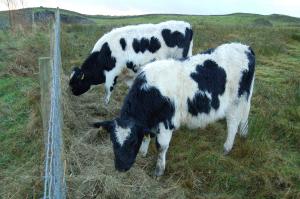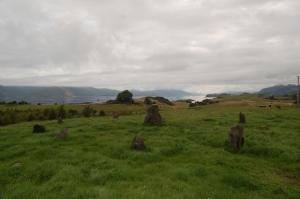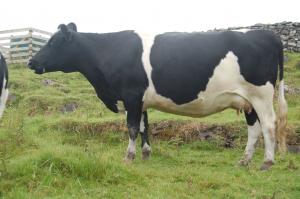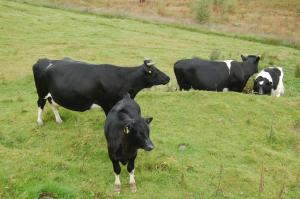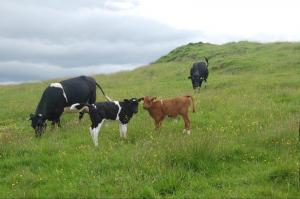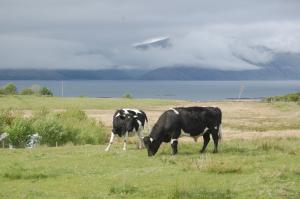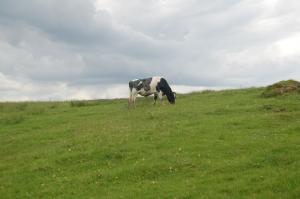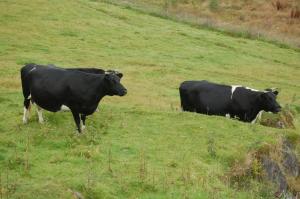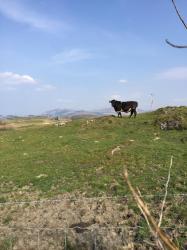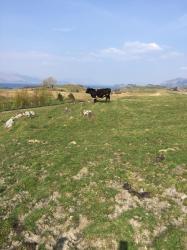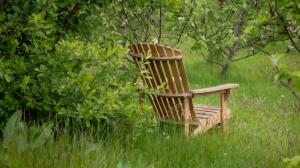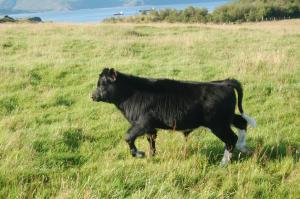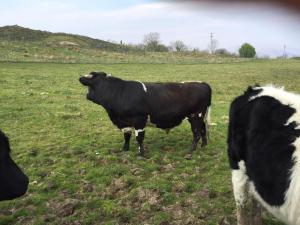"Lismore" - Isle of Lismore, Inner Hebrides, Scotland
“Lismore” Herd - Eva Tombs-Heirman, Isle of Lismore, Inner Hebrides, Scotland.
How it all started
I have had a hankering for living in the country from the moment I arrived in the city. Well, I was born in a city, in The Hague in Holland. When I was a child, we emigrated to California. That was way back in 1962 and California still had lots of space. We moved house frequently, sometimes we lived in farm houses and sometimes in the suburbs, but always near mountains and rivers or the ocean. A great love of nature, of growing food, of caring for animals, of native American wisdom and European herbal and homeopathic medicine poured into me from my parents, from the communities we lived with and from the earth and sky and sea. I acquired a horse at age 14, my first big animal, which I rode bareback in the hills.
In 1969 I arrived in Scotland. I had just finished high school after attending both in Holland and in Illinois in the US and was wondering what to do with my life/education. I did go back to the US several times to study medicine there but never felt right there any more. I am European and I prefer to speak English! My first job in Scotland was working with special needs children and then I worked on a farm there for a short while.
Fast forward 50 years
Having brought up my children, worked hard, many years a restauranteur, a dress and knitwear designer, a health researcher and as a full-time homeopathic practitioner. I developed and closed down businesses and laid my parents to rest. Then, a new window opened up. Could I now, finally, move back to the country? Live and work with nature again?
While I was doing a research project for a post-graduate degree using qualitative methods at the medical school at University of Edinburgh I became very interested in the Gaelic culture; the language, the history, the stories, the music, the landscape. (The School of Scottish studies is just around the corner from the Public Health department where I had my office.) They have a great library and many extra-curricular events and lectures that anyone can attend. I made some friends and with one lady in particular, Margaret, who was from the Island of Lismore. Although she lives in Edinburgh, she still had her ancestral home on the Island of Lismore. It wasn’t long before she invited me for weekend visits, this became a frequent occurrence. With a native Gaelic speaking accomplice it was easy to meet native farmers.
The island of Lismore is in the Inner Hebrides. The Highlands on the West Coast of Scotland receive more than 4m or rainfall annually. The winds are often fierce, gusts of 60 mph are not unusual and may reach 90 mph. Power cuts and lightning strikes happen all the time and it is necessary to prepare for them with candles and torches at the ready.
I found our land by speaking to a farmer on Lismore who seemed to understand what I was looking for and was willing to part with a piece of land that was becoming too much for him to manage. It was a large field, surrounded by broken-down boundary walls of dry-stone dykes, with areas of bog and a spring and a ditch. No road access and locked in between three different land owners, 40 acres in all. It was beautiful! High land with big views of mountains and sea. Bare and over-grazed with not a tree in sight. Such an amazing opportunity, I could see it all straight away, all the things that I could do there.
My partner and I designed the house we wanted to build, modest and easy to manage on ecological lines. I designed the garden for medicines, for food, for beauty and balance. I learned about reforestation as the bareness and lack of trees was a shortcoming here. So much soil had been lost and rushes and thistles, docks and rank grasses were getting the upper hand in some places.
I tried to get an agent to help me with grants and all the officialdom around farming and tree planting but they were all over prescribed, too busy to take on such a small farm. So, I read all the government websites and applied for Forestry grants. We hired a local chap to help one of my sons and my husband do the fencing. We created 5 small woodlands, which I planted up with 8000 native trees, 4 ha in all.
The farmer I had bought the land from was still grazing his own sheep and cattle on the land, which did cause some problems for the house build, but I’d promised that he could keep grazing his animals as long as he wanted, in exchange for letting me buy it in the first place. After four years like that he decided to stop grazing up here and told me he was removing them and that I now had to get my own animals.
I decided against sheep, mainly because I felt it better for the land to be without them, at least for a while. I researched the breed of cattle best suited for the place. I read every book I could find about managing cattle, about farming with nature. I talked to the local farmers and asked many, what must have been, some strange questions. They were encouraging and supportive and probably also somewhat bemused.
Once I had decided on the breed it was time to look for a small herd to buy. Here the SCBA and SCHBS were very helpful. It was my good fortune that a farmer with about 30 Shetlands was stopping with cattle and he helped put together a small group of two in-calf cows, with their calves and a young bull calf from a different line. That was a good start and they arrived on Lismore in November, 2015. I was so nervous and anxious as a new cattle parent! It took me at least a year to feel at ease with the whole ‘keeper of cattle’ experience. I was a bit like a new mother I think, watching them all the time, learning and watching and worrying.
For the first few years the cows produced more boys than girls. Having to take them to the abattoir is a difficult thing to do. Deciding on which abattoir to use, there aren’t many small ones left, they are all far away, I’m on an island. Borrowing a trailer. Another big learning curve another hurdle to overcome. The ear tags and castration, the paperwork, the BVD testing, the government red tape procedures, all quite a challenge to remember and do it correctly and on time. The “department” as they call it here (SGRPID) has also been an invaluable source of information for all things relating to setting up, to grants, to regulations.
I had decided from the very beginning that I wanted to be Biodynamic, that is Organic with bells on, I might tell you about all that another time. I will tell you though, that it involves keeping horns on cattle, keeping a closed herd, producing all food stuff for the animals on the farm itself, not using any chemicals such as antibiotics, pesticides, herbicides and regarding and treating the farm as a whole system. Fertility comes from the cattle and from compost, not fertilisers, and adding fermented herbal starter remedies to the composts and to the fields on a regular basis. This may be a bit easier for me to do than for some others, as fortunately homeopathic medicines work very well with animals, and as an experienced homeopath I will often know what to use. I make the remedies up in spray bottles which I either spray directly onto their nose, or add to their drinking water.
The local vet is kind and helpful. I hope he approves of the way I do things. He doesn’t exactly make much money from our farm. He is always willing to answer any questions and will come over when I ask him to. He has trimmed a hoof, he has castrated when the ringing didn’t work, and when a horn was threatening to grow into a skull he trimmed that. He has even bought meat from us! The local farmers have also been very helpful, showing me how to ring the boys and how to do the ear tags. One came over with a wire cutter in an emergency, when a cow and the bull became entangled through a fence.
The local way of cattle breeding and the way they raise their beasts is very different from the way I have chosen to do it. They all, apart from one other farm on Lismore, keep the mothers and a bull and sell off the offspring every year at the Oban mart in early December. They generally winter them in a shed, feed them silage and bought-in hay and nuts. They spend a lot on feed, on vet bills and meds! They also have a lot of sheep, which is also expensive and labour intensive and can leave toxic traces (in my view anyway).
I don’t have a tractor but I know how to scythe. For the first three years we had to buy in hay, small bales (no tractor). Now, we make enough hay to last us. Getting it dry in a place where it rains all the time, the west of Scotland, is a challenge. If I had more land, there’s never enough land, I would perhaps try the foggage method.
I do love traditional tools and the scythe in particular is a true gift to farming. I use an Austrian scythe, which is light weight, with wooden handle and easily sharpened to a razor’s edge. It took us a few years to learn the whole process; when, how and where to cut the grass, how to dry it properly and how to store it. We tried many different ways and hopefully we now have it right for us here. We did try stooks and tarpaulins and many other traditional methods, but it all just either blew away or rotted. We now have acquired a two wheeled tractor with a scything attachment, to speed things up and save my shoulders, as we don’t often have more than a few days of good weather at a time. There’s really nothing worse than scything for days just to have all the hard work ruined by a week of rain.
Almost as soon as the hay is cut, we collect it up in used, ton, builder’s bags (free from our local log merchant) and spread it out in ridges on the road. If we leave it on the place where it was cut, it will take too long to dry. We turn the hay several times a day and if rain threatens, we put it all into the bags again with pitch forks and drag it into the shed. When the rain is over and the road has dried, we put it out again and take it in at night. It may take 2 or 3 days of this carry-on to get it properly dry. We also scythe the grass roof of the house, which provides quite a bit.
Days are very long here in the summer, they start a 5 am and finish at 11pm, so plenty of time. Once all the hay is in, we take a week or so to check every bag several times a day, and turn the hay in the bags to get every bit of moisture out. Then we empty out all the bags one by one and make a huge haystack in the shed in a temporary make-shift frame. Placed on used pallets, so air can get underneath and with space all around. The whole process can take up to month to complete. This is truly our pride and joy, once it’s done, and we are ready for the next long winter.
Living on an island can add a lot of expense to buying in feed. Being certified Biodynamic can also be very expensive as hay and feed need to be by derogation and certified organic. Our own hay is beautiful, full of herbs and flowers and smells delicious, so much nicer than any bought in. Commercial nuts and pellets are made with GMO soya (usually), or grass that has been grown using artificial fertilisers, not something we really want for our cattle.
I also don’t do the strip grazing. With a bull to accommodate and all the different ages of cattle and types of land and managing the access to water, and my lack of enthusiasm for electric fencing it is just a step too far. I do know that I spend hardly any money on the cattle. None on fuel, no vet bills, no feed. They do have a salt lick and sometimes a garlic lick if the flies are bad and worms are too prolific.
In the spring I gather seaweed from the shore for them for extra minerals and energy. Cattle brought up near the sea will browse seaweed whenever they can, it’s tasty, salty and full of minerals. Many minerals are lacking in our grass, due to over-grazing and particularly due to the leaching from excessive rainfall. Seaweeds are very high in many minerals, proteins, vitamins, fibre, and various phytonutrients, including all the ones they put in licks (many licks incorporate seaweed just for that reason).
The seaweed most cattle seem to like are Pelvetica caniculata Channel wrack, which grows near the high-water mark, it’s easy to get, very tender and tasty, and Ascophyllum nodosum or Egg wrack, grows on the middle shore and has long fronds with egg like bobbles and very tender shoots at the ends. Both these are cut with scissors from plants that are alive and growing and are fed fresh to the cattle in the field or in a trough as soon as possible after collection. They will regrow from their intact roots. April and May are the main times for the Seaweeds as that is when they are tastiest and is also when the cattle seem to want them. Both are also edible for humans, raw is best. Though not too much as the Iodine content is quite high.
Where we are now
The number of cattle varies from 8 to 12. Every year I take at least two beasts to the abattoir. I sell the meat from the farm and occasionally to an organic box scheme supplier. I sold an in-calf cow with her daughter last year to another Biodynamic farm. I regret that in some ways, but I am learning so much all the time, about herd dynamics, about breeding, about herd health and well-being and about my own love for these wonderful, amazing, noble, funny creatures and how they improve the land, create a home for us and everything living here on this little farm. They really are the heart of the farm and our life here.
My garden is open to the public for charity and to allow people to see Shetland Cattle and learn about Biodynamic agriculture. See: www.scotlandsgardens.org and look for ‘Lismore Secret Garden’ in the search box.
The seat in the photo is in the orchard waiting for your visit!
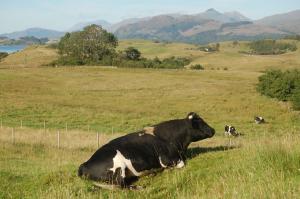
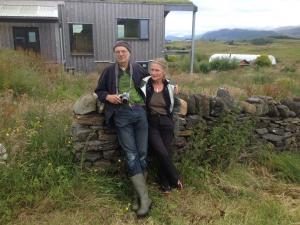
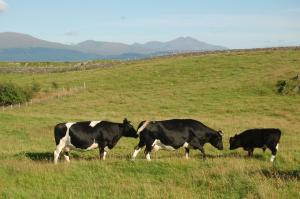
.d82853480e0a1ad737837484b5ae1eda54.jpeg)
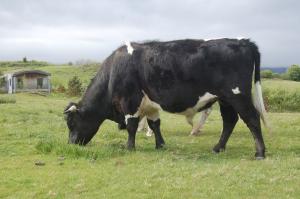
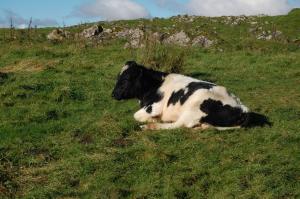
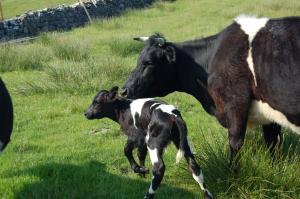
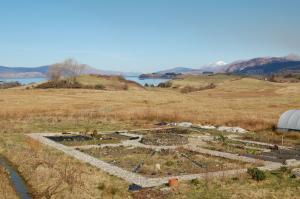
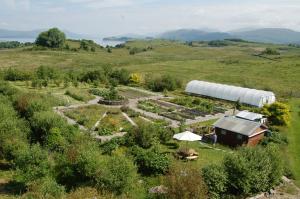
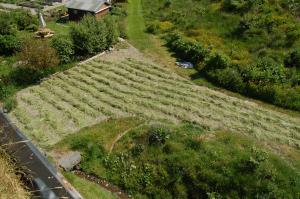
.666faef8979533cd2ff1c258d5d9b22154.jpg)
